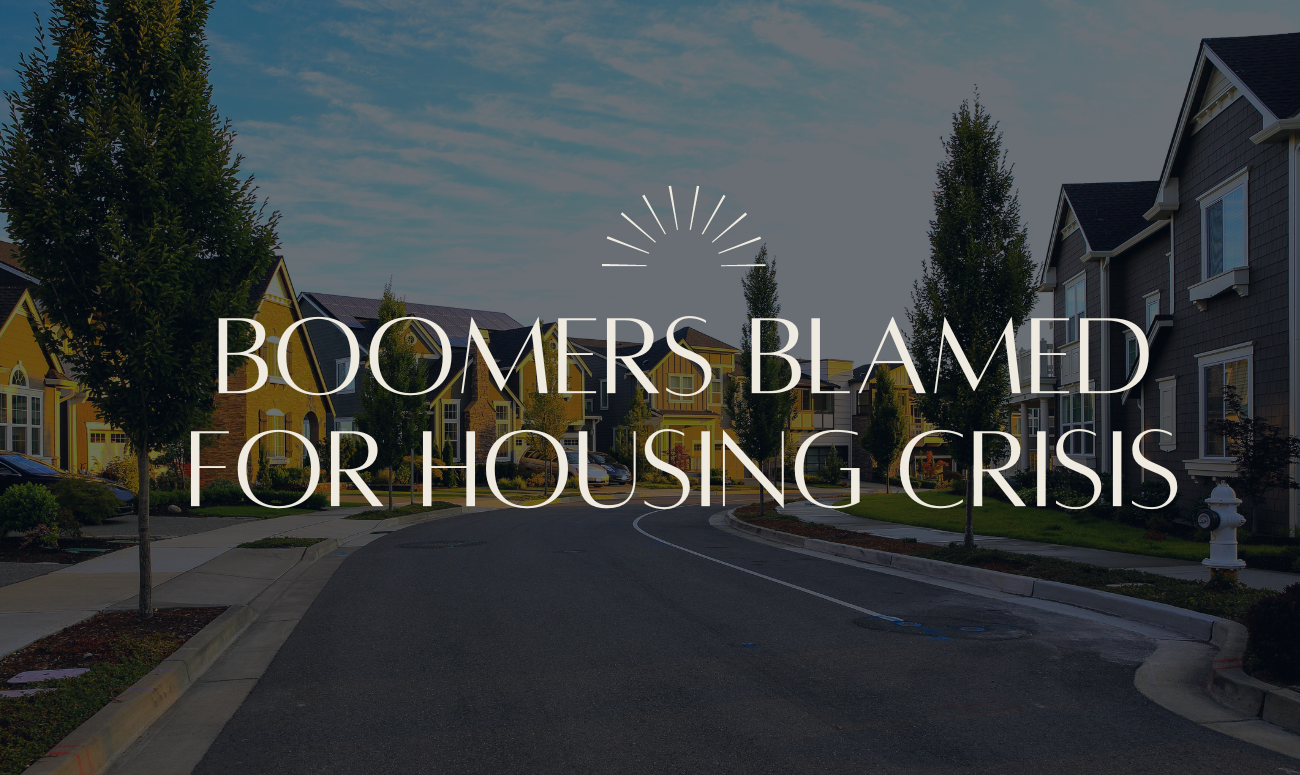Boomers Blamed for Housing Crisis: The Baby Boomer Housing Crisis: Why Aren’t They Moving?
Indeed, a recent report from real estate brokerage Redfin has revealed a startling trend – older Americans are aging and staying put in their homes, making it increasingly difficult for homebuyers to find and afford houses. In fact, the analysis found that a U.S. homeowner spends an average of nearly 12 years in their home nowadays, up from just 6.5 years two decades ago. Consequently, this is contributing to the lack of housing inventory and driving prices higher across the nation.
Boomers Blamed for Housing Crisis: The Data Doesn’t Lie
Using historical county records, Redfin’s research team discovered that nearly 40% of baby boomers have lived in their current home for at least 20 years. Additionally, another 16% have resided in their home for 10-19 years. On the other hand, less than 7% of millennials have lived in their home for 10 years or longer. This disparity can be partly attributed to millennials being younger and more prone to switching jobs than their older counterparts.
Boomers Blamed for Housing Crisis: Financial Incentives for Staying Put
The findings also reveal that older Americans are clinging to their homes because they’re financially incentivized to do so. In fact, more than half (54%) of baby boomer homeowners own their properties free and clear, with no outstanding mortgage. As a result, their median monthly housing cost, which includes insurance, property taxes, and other expenses, is just over $600.
Moreover, nearly all boomers who do have a mortgage are paying a much lower interest rate than they would if they sold and bought a new home with today’s interest rates. For context, as of late February 2024, the current 30-year fixed mortgage rate stood at a staggering 6.77%, according to data from Freddie Mac.
Boomers Blamed for Housing Crisis: Tax Incentives Reinforce the Trend
Furthermore, some state tax systems have policies that make it financially beneficial for people to stay in their homes as they get older. For example, Texas homeowners over 65 can defer property taxes until the home is sold. Similarly, in California, Proposition 13 limits property tax increases, providing another incentive for long-term homeownership.
The data found that California homeowners typically stay put the longest, partly due to this property-tax incentive. Specifically, the typical Los Angeles homeowner has lived in their home for 18.7 years, followed closely by 17.8 years in San Jose.
Boomers Blamed for Housing Crisis: A Vicious Cycle of Low Inventory
Since people are staying in their homes longer than ever before, Redfin asserts that this has directly contributed to the lack of housing inventory plaguing many markets. Subsequently, this shortage of available homes has ultimately pushed prices higher, exacerbating the affordability crisis for first-time and younger buyers.
As Redfin bluntly stated in their report, “Long homeowner tenure, particularly among baby boomers, is an obstacle for young first-time buyers trying to break into the market.” The numbers certainly back up this assertion – in 2023, existing home sales plummeted to just 4.09 million units, the lowest level since 1995. Conversely, the median price reached a record high of $389,800 that same year.
Boomers Blamed for Housing Crisis: Looking Ahead: Will Tenure Remain High?
Although total housing inventory was down 11.5% from November to December 2023, it was still up 4.2% compared to one year prior. According to the analysis, homeowner tenure peaked at 13.4 years in 2020, just when the COVID-19 pandemic set off a frenzy of moving activity. However, it has declined slightly since then.
Moving forward, Redfin predicts that homeowner tenure is likely to stay relatively flat or potentially increase slightly for the foreseeable future. While they anticipate sales should pick up a bit in 2024, it’ll be “more of a trickle than a flood.”
Boomers Blamed for Housing Crisis: The Boomer Homeownership Boom
Homeownership has long been considered a quintessential part of the American dream. However, first-time home buyers, especially millennials and Gen Xers, are facing an uphill battle when it comes to house hunting. This is in large part due to the growing trend of baby boomers, the generation that owns the largest share of American homes, planning to age in place and stay put. In fact, a 2021 survey conducted by AARP found that a staggering 77% of Americans over the age of 50 would prefer to remain in their current home rather than move in with family, to a nursing home, or to an assisted living facility. Consequently, this is leading to constrained inventory levels for prospective new buyers.
Boomers Blamed for Housing Crisis: The Shifting Homeownership Landscape
According to data from the U.S. Census Bureau, the share of homeowners over the age of 55 has been steadily increasing over the past couple decades. In 2008, at the onset of the Great Recession, Americans over 55 owned 44.3% of homes nationwide. However, by 2021 that percentage had ballooned to 54.2%.
In contrast, while the share of homeowners under 35 remained relatively steady during that same period, the percentage of owners between 35-54 years old decreased from 42.3% to 33.8%. That said, in 2022 the 55-and-older cohort did cede a bit of homeownership share, dropping slightly to 53.6%. Conversely, homeowners under 35 (12.2%) and those 35-54 (34.2%) both saw modest increases in their respective shares.
Boomers Blamed for Housing Crisis: Boomers Dominate in Certain Regions
While baby boomers (defined as those between 58-76 years old in 2022) comprise just over 20% of the total U.S. population, they account for a disproportionately high 38% of homeowners nationwide. Notably, boomers are especially dominant in the housing markets of many New England states. For instance, they make up 42.5% of homeowners in New Hampshire, 42.0% in Vermont, and 41.7% in Maine. However, Delaware leads all states with a whopping 42.7% boomer homeownership rate.
On the flip side, several Midwest states tend to have lower concentrations of baby boomer homeowners, such as North Dakota (35.5%), Nebraska (35.6%), Minnesota (35.7%), and Indiana (36.0%). That said, Utah stands out as an outlier with only 30.4% of its homeowners being baby boomers, the lowest rate in the country.
Boomers Blamed for Housing Crisis: Metro Level Boomer Homeownership Rates
At the metropolitan level, locations in the Northeast like Pittsburgh (40.0%), Rochester (40.0%), and Buffalo (39.0%) have some of the highest concentrations of baby boomer homeowners in the nation. Similarly, several major warm-weather metros also boast highly baby boomer-dominant homeownership numbers. Leading the pack is Tucson, where a staggering 41.8% of homeowners are between 58-76 years old.
Other cities with elevated boomer ownership rates include Tampa (40.0%), Los Angeles (39.0%), and Miami (38.9%). It’s worth noting that many of these areas with high boomer homeownership shares are likely attractive retirement destinations, which could be contributing to the elevated percentages.
Boomers Blamed for Housing Crisis: The Bottom Line
In summary, the large baby boomer generation is increasingly choosing to age in place, resulting in much lower housing turnover than in previous decades. Thanks to factors like longer life expectancies, the ability to pay off mortgages, favorable tax policies in some states, and a general desire to remain in familiar surroundings, boomers are staying put.
While this living situation may be ideal for those seniors, it’s causing severe inventory shortages and making homeownership far less attainable for younger generations. Unless boomers start downsizing or selling their homes at higher rates soon, the U.S. housing market could remain stuck in this challenging low-inventory rut for years to come. Potential policy solutions to incentivize boomers to sell could help alleviate the inventory crunch. However, in the meantime, the dream of homeownership will likely remain elusive for many first-time millennial and Gen X buyers across large swaths of the country.
If you are looking for a St Petersburg Real Estate Agent visit https://avalongrouptampabay.com/




